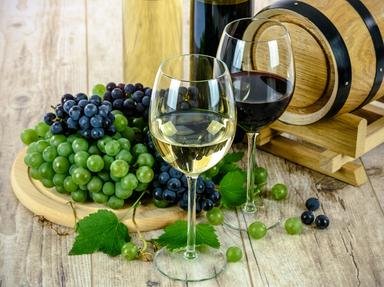Quiz Answer Key and Fun Facts
1. You are having some friends over for dinner, so your wife sends you off to the wine shop to purchase a bottle of wine. Which of the following is going to be the most important consideration in selecting which wine you are going buy?
2. You arrive at the wine shop and find yourself confronted with row after row of various wines. You feel totally lost. Since you are a novice when it comes to wine, what is your best course of action?
3. An employee sees you standing in the middle of the aisle, and comes over and asks if he can help you. You tell him that your wife is making a top sirloin roast, and has sent you to buy a bottle of wine that will complement her entree. Which of the following wines is he most likely to suggest?
4. The employee leads you over to another aisle where there is still what seems to be a bewildering number of choices. Many of them seem to be very, very expensive. Is it necessary to spend a lot of money to get a good bottle of wine?
5. You tell the helpful employee about how much you are prepared to spend, and he pulls a bottle off the shelf and hands it to you. "It's a good year," he says. A good year? What does he mean by that?
6. You look at the bottle. On the label it says Chateau Malescasse 2009. At the bottom of the label it says "Mis en Bouteille au Château." Is this a guarantee that you are getting an outstanding wine?
7. Another look at the label shows that it says it says "Cru Bourgeois." What does this mean?
8. You notice that the neck of your wine bottle is closed with a cork. Do you have a corkscrew at home? Yes, there's one somewhere. Some of the other bottles you have seen in the store have screwcaps instead of corks. What is the main reason some manufacturers have switched from corks to screwcaps as closures for their wines?
9. You decide that the bottle you've been looking at is a good choice. You pay for it, and take it home. Your wife approves, and says, "You'd better open that now. The Millers will be here at six o'clock." You are once again confused. It is only 4PM. Why does your wife want you to open the wine now?
10. It's almost time for dinner. The roast smells wonderful, and your bottle of wine smells good, too. About twenty minutes before your guests arrive, your wife tells you to put the wine in the door of the refrigerator. You tell her that red wines are meant to be served at room temperature. She tells you to shut up and do as you are told. Why does she insist on doing this?
Source: Author
daver852
This quiz was reviewed by FunTrivia editor
WesleyCrusher before going online.
Any errors found in FunTrivia content are routinely corrected through our feedback system.

